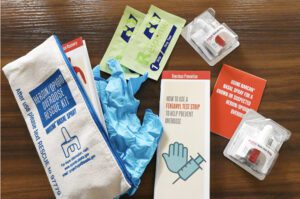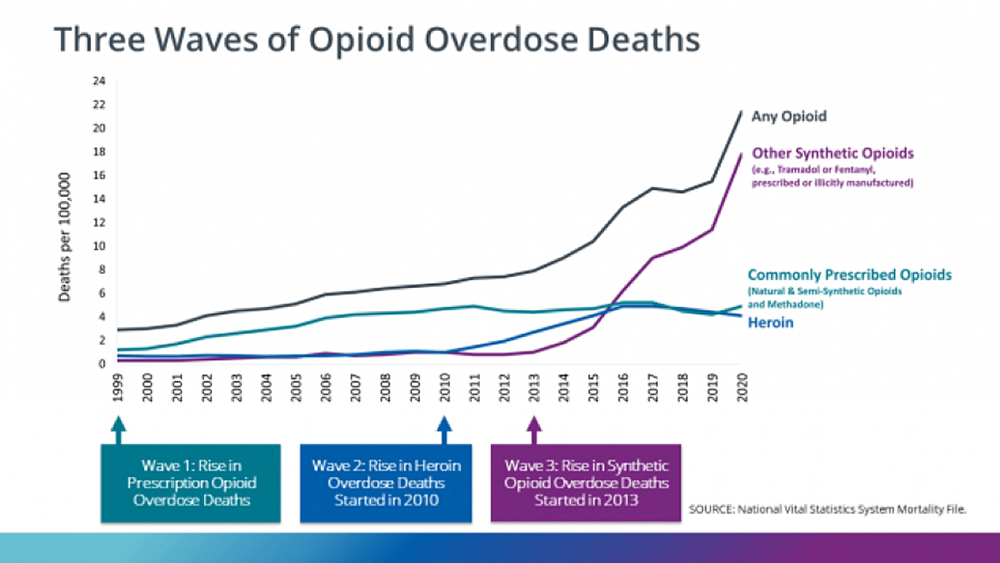
Watching friends, family, or crew members struggle with addiction is devastating. It is tempting to bury our heads in the sand and pretend that addiction won’t impact our family, friends or crew, but denial doesn’t change the odds.
Over the last few decades, deaths due to overdoses have continued to rise. There are three distinct waves of opioid use, defined as Rx opioids in the 1990s, heroin in 2010 and synthetic opioids in 2013. We are still experiencing the effects of the synthetic opioid wave.
Unfortunately, synthetic opioid use has proven to be the deadliest to date, killing 8.5 times as many people as in 1999. As firmly as we believe that we will never have to deal with an overdose on our vessel, the truth is that each year, as addiction rates continue to rise, you are at an increased risk of exposure to an overdose.
Nearly 92,000 Americans died from an overdose in 2020. Out of those 92,000 people, 75% involved an opioid. Most overdoses occurred in men between the ages of 25-45, the same population that makes up the majority of crew members on commercial fishing vessels.
Unfortunately, the fishing lifestyle predisposes some fishermen to develop a drug addiction due to long hours, hard physical labor, pre-existing musculoskeletal injuries, isolation, a high tolerance for risk and an influx of cash coinciding with free time on shore.

Opioid Response Kits
Most people who witness an overdose on shore can summon medical assistance within minutes. Mariners are not so fortunate. If there is an overdose while out fishing, support is often too far away to save the victim. For this reason, boat captains and crew members should always have an opioid response kit with naloxone onboard. And, if not for your own crew, then for your neighboring fishing partners’ crews. Living in close proximity to crew members, your chances of catching an overdose before it’s too late are better than most.
Naloxone is a medication that kicks the opioids off the opioid receptors in the brain, which allows normal bodily functions to commence. Narcan or Kloxxado are two opioid response brands that can administer naloxone to a patient through a nasal spray.
You give one blast of medication into a nostril, which should work within 2-3 minutes. Call for medical assistance as soon as you’ve administered the naloxone. Give a second spray if there is no response after 2-3 minutes. If the person is still not breathing, begin CPR with rescue breaths while waiting for aid.
Fentanyl is a synthetic opioid that is over fifty times stronger than heroin or other opioids and is increasingly common. Kloxxado contains double the dose of naloxone as Narcan, so it may be more effective at counteracting the increased strength of fentanyl.
Naloxone’s effects last 30-90 minutes, so victims may need a second dose if help hasn’t arrived. If someone is unconscious for any reason other than an opioid overdose, giving naloxone will not hurt them. Err on the side of action if you suspect an overdose has occurred. Never leave someone who has overdosed alone, even after they received naloxone. Vomiting can occur after a naloxone treatment, necessitating turning them on their side to prevent asphyxiation.
Every state has different rules about naloxone distribution. There is no “one size fits all” solution to fighting overdoses. In most states, people may purchase naloxone from pharmacies where they will receive basic training in recognizing the signs of an overdose and how to use the medication.
In addition, many states have programs to help distribute naloxone to people for free if they are at an increased risk of witnessing an overdose. Fishermen fit the parameters of a high-risk environment without readily available medical professionals.
As with most marine disaster training, you hope you never have to use the skills you acquire. In this case, you hope you never have to witness an opioid overdose and that your Narcan/naloxone sits in your medical kit unused until its expiration date, typically between 1-2 years.
So, when you look through your first aid kit this year and check expiration dates, add naloxone medication to your equipment. A minor action could have life-saving results.

Crew Familiarization
In preparing for marine disasters, we use our tools to mitigate risks, prepare for disasters, and perform drills as if we were in the midst of a disaster. When facing addiction, we must recognize that it exists even where we wouldn’t expect it. Get to know your crew before you head out on the water. Does everyone have enough of their prescription medication on board? Have all illegal substances remained onshore? Are people in an adequately stable emotional state before heading out on the water?
Skippers are not immune to addiction problems, so as a crew member, familiarize yourself with marine radios and how to call for help. Do you know where the first aid kit and other survival equipment are stored?
Sometimes crew members are most aware of what their crewmates are doing, and if you realize that someone on your boat is using opioids, you are putting that person, yourself and everyone on the ship at risk if you don’t let the skipper know about the situation.
Everyone on the boat should prepare for the possibility of an overdose on your vessel or a neighboring vessel. You are likely to be the closest aid for your fellow fishermen. If you can safely assist, it is your responsibility to do so.
Ideally, you can prevent an overdose from occurring in the first place, but should that fail, naloxone is the best tool for reversing the effects of an overdose and saving a life.
The Alaska Marine Safety Education Association (AMSEA) has a mission is to reduce injury and death in the marine and freshwater environment through education and training provided by a network of marine safety instructors. The Sitka, Alaska-based organization has been offering marine safety training to commercial fishermen and thousands of other mariners since 1985.
More information on marine safety topics can be found at www.amsea.org
